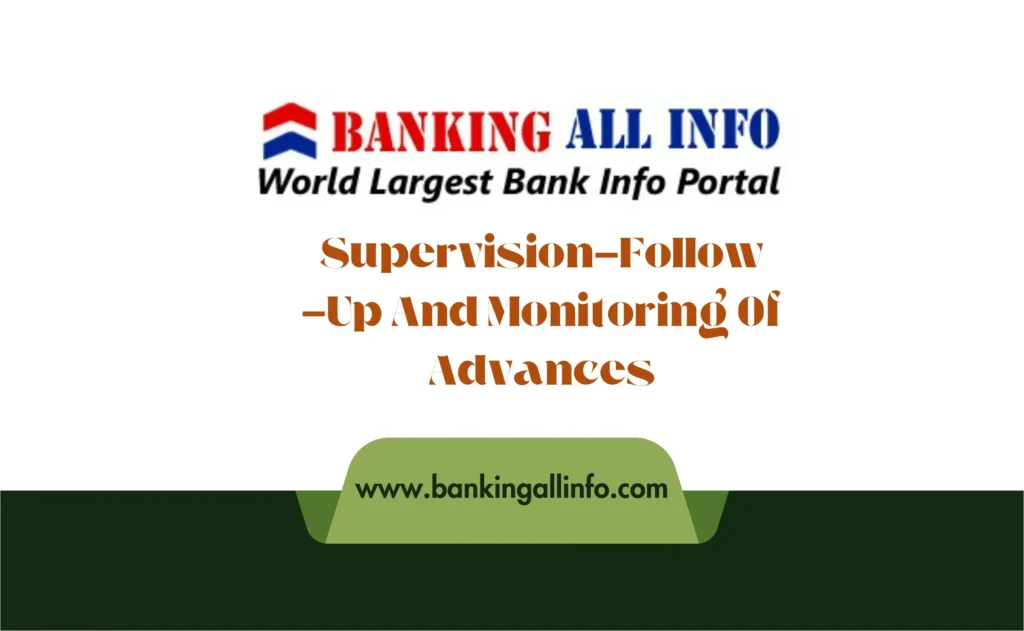Supervision-Follow-Up And Monitoring Of Advances
Lending is one of the most important functions of a commercial bank and with the modern concept of social order and participation of commercial banks in various phases of commercial, industrial, agricultural and other economic activities of the country, it is of paramount importance that banks have to be very careful while choosing a borrower. Before sanctioning a loan a banker carefully appraises the loan proposal of the borrower & to determine their credit worthiness on the basis of principles of sound lending
Simply an appraisal of loan proposal is not a guarantee against risk of non-payment by the borrowers. This is only a part of the job.The other and equally important responsibility of the lending banker is to follow-up and supervises the use of the credit.

2. So, a banker while sanctioning any loan should ensure that the credit facility is allowed to the genuine borrowers for genuine economic purposes, money lending is properly used for generation of income through increased economic activities and the borrowed money is repaid in time. All these can be ensured through an effective supervision and follow-up system of the advances.
3. Supervision and follow-up are closely related. Supervision gives more emphasis on proper end-use and follow-up gives more emphasis on timely recovery of advances.By supervision we mean to have a proper control over the borrowers’ operation to ensure the end use of funds.
4. Supervision keeps track of the end-use of fund lent. It includes adequate arrangement by bank for maintaining close contact with the borrower and his activities in order to remain well informed about the position and progress of the project financed and to offer appropriate guidance to the borrower, where necessary.
Follow-up includes efforts to ensure that the terms and conditions of the advance at:
Pre-disbursement,
Disbursement,
Post-disbursements and
Recovery stages are complied with and money lent is repaid as per schedule of repayment.
It also includes efforts to regularize the irregular advances. Recovery of advances largely depends on effective follow-up.
Follow-up is the systematic process through which these activities are carried out.
5. The basic objective of supervision and follow-up system is to ensure that the advances granted by the bank are safe as the funds lent by banks belong to the depositors and the bank management has tremendous responsibility in safeguarding the interests of millions of depositors. Supervision work of loan starts right from the stage of selection of a borrower whereas Follow-up work of loan starts immediately after disbursement of the loan.
6. Supervision and follow-up of advances are the direct responsibilities of the branch. Branch is the unit wherefrom the proposal is made for any advance and disbursement is made. The borrowers maintain his account with the branch, operations are conducted through the account, reports, and returns are submitted, by the borrower to the branch. So success depends on how effectively the branch ensures supervision and follow-up of the advances.
7. Bank branches responsible for supervision and follow-up have to follow the following:
(a) To ensure that operations of accounts are regular, Bad indications warrant greater supervision.
(b) To keep watch over the inflow and outflow of Fund.
(c) Maintenance of production and sales record.
(d) To verify proper end-use of funds for the purpose for which loan was given.
(e) Progress made in construction and operations.
(f) Inventory position and Turn over rate observation
(g) Ensure that security/collateral have been obtained as per terms of sanction.
(h) Ensure that the valuation of security has been assessed correctly.
(i) Position regarding insurance of goods.
(j) Ensure that the documents have been obtained as per terms of sanctions.
(k) Regular inspection of the security and verification of document.
(l) Reasons for default or delayed payment of loan installments.
(m) Appropriate actions are taken in time to regularize the irregularities and recover as per schedule.
(n) Keep regular contract with the borrower.
(o) To keep a watch on safety of funds.
(p) Ascertain financial positions of the borrowing concern from time to time through the study of audited Balance sheet/Financial statement.
(q) Obtain Periodical balance confirmation.
(r) Obtain stock statement as per terms of sanction against hypothecation and pledge of goods.
(s) Maintenance of limit registers.
(t) Non-compliance of any terms and conditions of the loan.
(u) Other account of the borrower.
(v) Miscellaneous.
1. Monitoring
– Monitoring is a process of ensuring that performance takes place in conformity with the plan. In case of project loan it starts from the selection of the borrower and remains to live throughout the life of a loan.
– It is in fact, an action inducing effort, meaning thereby that it would ensure that commitments made by various organizations are followed up by action.
– Monitoring basically involves three steps:
– Measuring
– reviewing and
– reporting.
2. Why Monitoring –
– Return flow of funds
– Problem solving
– Feedback.
3. Loan Monitoring requires information and use of Judgement:
– An information system provides data for analysis and judgement.
4. Method of obtaining Information:
– Reports
– Visit
– Discussion
– Financial Statement.
5. Monitoring when?
– During implementation stages
– During operation stages.
During Implementation Stage
– To see that the project is carried out as it was intended or modified in the light of changing circumstances.
– To see that the conditions of lending are complied with by the borrowers.
– To see that the proceeds of the loans and invertible funds are made available to the borrower according to project need and to see that the fund so released is utilized for the intended purpose.
– To see that the funds provided to the borrower are adequately safeguarded (such as security and insurance coverage)
– To synchronize the interest of the client with that of the lending institution it is necessary to assist the borrower in obtaining infrastructural facilities and govt. concessions and approval.
– To ensure adequate feedback to management and appraisal team in matters of cost over-runs, financing deficiencies and project implementation delays, if any.
During Operational Stage
– To see that the operations of the project are carried out as was intended or modified and that the terms and conditions of lending are complied with.
– To attend to the distressed accounts as long as the unfavorable conditions/genuine problems exists.
– To obtain payment of installment promptly and to prevent occurrence of arrears in the normal course.
– To provide the lending institution with a continuing source of data of financing and economic trends.
– To maintain a satisfactory relationship with the client with a view to promoting a well – balanced attitude of helpfulness and understanding.

